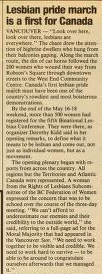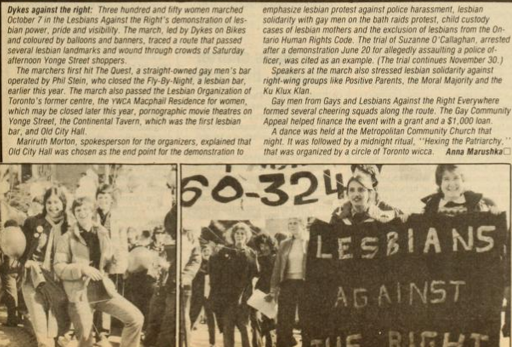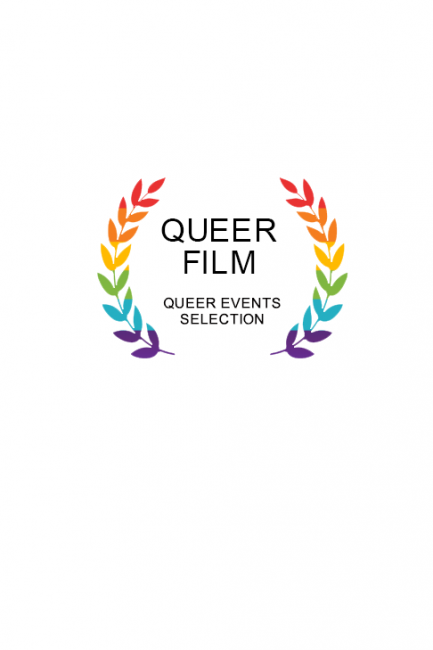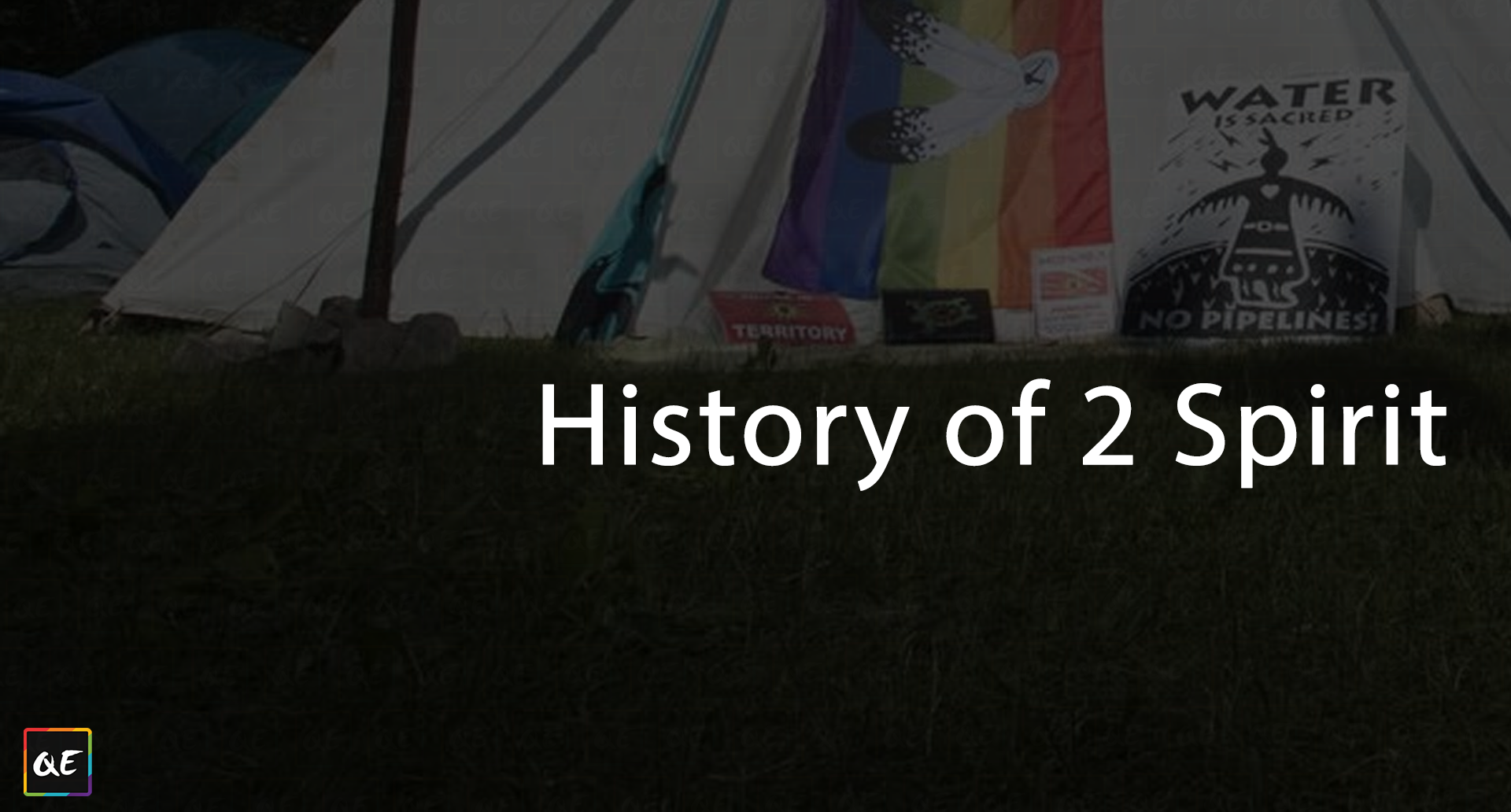
Eating Fire: A History of the Dyke March
An indomitable legacy is carried on to this day by Dyke Marches across the world, one that pushes back against centuries of erasure, oppression, and systematic cruelty. A spectacular act of protest, it challenged not only the injustices of government but also the male dominance within LGBTQ+ spaces. The main reason for the creation of the various Dyke Marches was to protest what many women saw as the control of Pride events by white gay men at the expense of lesbians in general and women of color in particular.

This march, that began in the 90’s, set a powerful precedent for lesbian organizing with marches including diverse women from every backgound united to claim the label of lesbian. Since it’s first protest, Dyke Marches have sprung up in cities around the world.. Thousands upon thousands of lesbians have marched for visibility, freedom, and community.
"the Lesbian Avengers decided to throw down the gauntlet and use the word "dyke." It was big and bold, and a declaration of independence from both the women’s and gay movements that had always sidelined us. It also thumbed its nose at the obsequious trend of some LGBT activism: "Please give us a few crumbs. We’re just like you, except for who we sleep with.""
While most historical accounts has the first official Dyke March taking place in 1993, the first documented lesbian march took place in Vancouver, British Columbia, Canada, in May 1981. Approximately 200 lesbians attending the fifth Bi-National Lesbian Conference marched through downtown streets chanting "Look over here, look over there, lesbians are everywhere!"
Later, on October 17, 1981, the now-defunct organization Lesbians Against the Right held a "Dykes in the Streets" march in Toronto, Ontario, with lesbian power, pride, and visibility as the theme. 350 women participated in this demonstration. It would not be until 15 years later that another similar demonstration would be held in Toronto.

The Lesbian Avengers
After these initial demonstrations, there are no surviving records of other official marches until 1993 when over 20,000 lesbians took to the streets of Washington DC the night before the scheduled March on Washington for Lesbian, Gay and Bisexual Rights and Liberation.
It was to be a protest like no other. As one Dyke Marcher shouted, “This is the largest lesbian demonstration in the history of the world!” Coordinated by the Lesbian Avengers, Dyke March was the first time that so many lesbians grouped together to claim public space.
The March on Washington for Lesbian, Gay, and Bi Equal Rights and Liberation
The Avengers handed out 8,000 flyers telling Dykes to meet at Dupont Circle at 5 PM on the evening of April 24th, 1993, for a Dyke March to the White House. More than 20,000 lesbians showed up and marched all the way to the National Mall. Lesbians from LA made a large banner and dykes from Philadelphia made a huge vagina which was carried like a puppet through the streets of Washington D.C. The New York Lesbian Avengers organized the logistics of the march, arranged for marshals, and created a manifesto addressing the necessity of grass-roots lesbian organizing, especially given the anti-gay bills being pushed by the right wing.
“This is the largest lesbian demonstration in the history of the world!”
As they marched to the White House, a group of Lesbian Avengers stunned the march by dramatically eating fire while the crowd chanted, “The fire will not consume us. We take it and make it our own.” The Avengers had started the fire-eating thing a few months before, to protest the firebombing deaths of Hattie Mae Cohens and Brian Mock, an African-American lesbian and a disabled, white, gay man, respectively.

Lesbians went home with that fiery image in front of their eyes. They not only started their own Avenger groups dedicated to “lesbian survival and visibility” but started throwing their own Dyke Marches, usually the day before their local pride parades. The first New York City Dyke March was held in June 1993. San Francisco and Atlanta also held their first Dyke Marches at that time. The New York City route began at Bryant Park and ended in Union Square Park where Heritage of Pride, the nonprofit organization that hosts the annual Pride March in New York City, was holding a rally. This March, like the March before it and all NYC Dyke Marches to follow, did not have a permit. It has been a founding statement of the dyke marches that it is our community’s right to protest, and until we are truly liberated, the Dyke March will always be a protest march.
Dykes, Dyke, Dykes
Before the Dyke Marches began, it’s not that lesbians had never marched before. Long before Occupy Wall Street, lesbians supported the community and marched for everything from the environment to racial equality and economic justice. In 1993 it was mostly AIDS and reproductive rights, and anti-gay violence. There had even been marches almost exclusively populated by lesbians, but they were usually called “women’s” (or “womyn’s,” or “wimmin’s”) marches, and you already had to be in the know to understand what was going on.
In this climate as described by one of the original Lesbian Avengers, Kelly Cogswell, explains that the “Lesbian Avengers decided to throw down the gauntlet and use the word “dyke.” It was big and bold, and a declaration of independence from both the women’s and gay movements that had always sidelined us. It also thumbed its nose at the obsequious trend of some LGBT activism: “Please give us a few crumbs. We’re just like you, except for who we sleep with.””
Making It Our Own
One of the enduring features of the dyke march that beats through its heart to today, is the sound of drum beats. This has been a feature of dyke marches all over and began in the 2nd Annual New York Dyke March, held in June 1994. Over 20,000 Dykes attended this march as well and the Avengers didn’t know how they would communicate that it was time to line up behind the banner on 42nd street. A group of drummers began marching toward the banner and all of the Dykes followed the drumming out of the park. Years later, dyke marches all over, still depend on the drummers to lead the dyke march and signal the start.
Today, while fire eating is absent, we are still led by drums, hundreds strong and arm in arm with a diverse group of individuals who all identify as dykes, whether trans or cis, of all races marching together for visibility and rights and is an experience no dyke should miss. The Dyke March is just as aggressively inclusive and grassroots as it used to be. That’s what makes it so revolutionary. The Buffalo Dyke March organizers have also changed their name to Dyke +, to be more inclusive to all gender identities, an intention that reflects the ethos of dyke marches everywhere. Along with being inclusive, organizations across the world are constantly advocating for causes outside of lesbian visibility.
The Dyke March remains essential in our queer history. The dykes’ long-standing commitment to protest has inspired the entire community. They have taught us how to take the fire used against us and make it our own.
Article sources, notes & media
Image credits (in order of appearance)
- Bearchell, Chris (June 1981). "Lesbian Pride March is a First for Canada". The Body Politic. Pink Triangle Press. p. 10.
- "Lesbians Battle the Right". The Body Politic. Pink Triangle Press. October 1981. p. 10.
- Lesbian Avengers Eating Fire Demonstration. Photo by Carolina Kroon.
Related Documentary
Food for Queers
Stay Safe. Not Hungry
Providing support for 2SLGBTQ+ folks experiencing food insecurities within the city of London












